The Television Legacy of Irwin Allen – Part III: Lost in Space
 Irwin Allen was a long standing fan of the book The Swiss Family Robinson and its story of a highly resourceful family stranded on a remote island. He modified this basic storyline to incorporate the 1960’s public’s fascination with space travel and the possible colonization of other
Irwin Allen was a long standing fan of the book The Swiss Family Robinson and its story of a highly resourceful family stranded on a remote island. He modified this basic storyline to incorporate the 1960’s public’s fascination with space travel and the possible colonization of other 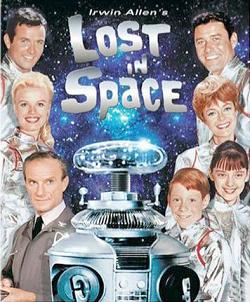 planets to develop his second science fiction television series. One year after the debut of his successful Voyage to the Bottom of the Sea, Allen pitched an entirely different kind of family drama in the realm of science fiction based fantasy. The original concept was rather obviously titled The Space Family Robinson but due to a similarly titled Gold Key comic book, the pilot was renamed after the general predicament of the plot to Lost in Space.
planets to develop his second science fiction television series. One year after the debut of his successful Voyage to the Bottom of the Sea, Allen pitched an entirely different kind of family drama in the realm of science fiction based fantasy. The original concept was rather obviously titled The Space Family Robinson but due to a similarly titled Gold Key comic book, the pilot was renamed after the general predicament of the plot to Lost in Space.
To play the world’s first family of outer space, Allen wisely chose some established actors and one talented newcomer. Guy Williams was cast as the father, Professor John Robinson; following a successful career playing action heroes including the title role in Walt Disney’s Zorro television series. The mother for the show, Dr. Maureen Robinson, was none other than Timmy’s mom on the popular television series Lassie, June Lockhart. As the short tempered but well meaning co-pilot, Major Don West, Mark Goddard was best known for playing cowboys and authority figures including a three year stint on the series The Detectives. Playing the Robinson children, son Will and daughters Judy and Penny were Billy Mumy, Marta Kristen, and Angela Cartwright. Both Mumy and Cartwright were veteran child actors, the former in an impressive string of appearances including several episodes of The Twilight Zone and the latter as a star of Danny Thomas’s Make Room for Daddy television series. Krista was the sole newbie in the cast having only done some modeling and minor roles before joining Lost in Space.
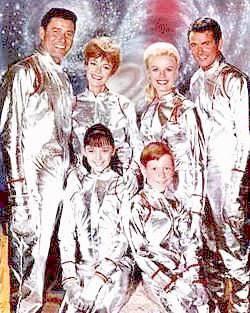
An early publicity photo of the cast before Dr. Smith and the Robot were added.
In the original pilot, No Place to Hide, the Robinson family and Doctor Donald West pilot the Gemini 12 ship on a mission into deep space, eventually reaching the inhabitable planet Alpha Centauri. Once on the planet, the pioneers set up camp and begin exploring their new world which includes giant Cyclops monsters and hostile weather conditions that the space probes never mentioned. Allen maxed out the special effects budget with a number of impressive sequences that would have thrilled audiences of the 1960’s if they had ever seen this version.
The CBS Television Network expressed interest in the show but they had two conditions, they wanted a villain and a robot. To accommodate them, Allen reworked the pilot to include an enemy agent who is accidentally trapped aboard the ship while sabotaging it just prior to take off. Dr. Zachary Smith was only intended as a guest star for the first few episodes but, as played by the marvelous Jonathan Harris, the character immediately endeared himself to audiences and he quickly became a regular. The requested robot was the wonderous B-9 Environmental Control Robot who was simply referred to as “Robot”. The costume was designed by Robert Kinoshita, creator of the equally famous Robby the Robot for the classic science fiction film Forbidden Planet. Inside the suite was actor Bob May but the distinctive voice of the robot was provided by the show’s announcer, Dick Tufeld.
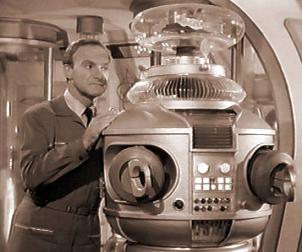
Dr. Smith and the Robot look a little more sinister in black and white.
Along with the two additional characters, the modified pilot made a few changes to the existing story. The character of Donald West was changed from a Doctor of Astrophysics to a Major in the United States Space Corps, presumably to make him more heroic and a better contrast to the scientific family. For less obvious reasons, the name of the ship was changed from the Gemini 12, which fit perfectly within the actual US space program, to the Jupiter 2 and the interior was expanded to include a second level with living quarter. These changes required additional footage to be shot so the special effects footage from the original pilot was rationed out across the first few episodes of the new series. To accommodate this, several plot devices had to be concocted to separate Smith and the Robot from the rest of the case periodically.
In the final version of Lost in Space that millions of fans have come to know and love, the Robinson’s mission is disrupted by the villainous Dr. Smith and they actually do end up lost. After getting himself trapped on board, Smith is forced to revive the crew in the hopes of being returned home. Instead, his weight throws off the automated guidance systems and the ship is damaged in an asteroid field it would have otherwise avoided. With no hope of returning to Earth or completing their original mission, the Robinsons were forced to land on the nearest inhabitable planet and set up camp until the ship could be repaired.
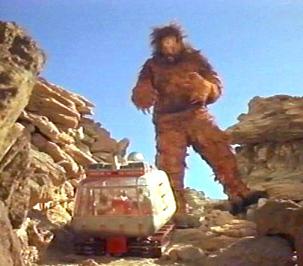
A rare color photo of the Cyclops encounter from season one.
Like Irwin Allen’s earlier series Voyage to the Bottom of the Sea, the first season of Lost in Space was filmed in black and white and while the stories featured plenty of fantastic elements, they were firmly rooted in strong family values. After two episodes in space, the Jupiter 2 crashed on an inhabitable but largely barren planet and the show spent the rest of the season on solid ground. There they would encounter a fellow astronaut from Earth, an evil Robby the Robot, and multiple varieties of alien visitors. In the only two part story of the entire series, Michael Rennie from The Day the Earth Stood Still guest stared as the owner of a space menagerie who gave the story its title, The Keeper. Rennie’s character wants to add Will and Penny to his traveling zoo and Dr. Smith sees this as his ticket home until he accidentally releases all the creatures! Like this story, many of the early episodes were genuinely frightening. In There Were Giants in the Earth, which was built around recycled footage of a gargantuan one eyed monster from the pilot, the likable family was menaced by a seemingly unstoppable beast until their advanced weaponry got the better of it. I still remember the first time I saw this episode and sat riveted to the television set as the Robinsons road past the fallen, but still scary, Cyclops in their futuristic ATV, the Chariot. The musical cues and sound effects of the growling creature only intensified the atmosphere.
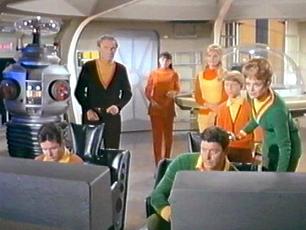
The new color sets for season two.
The final episode of the first season is a stand out and arguably the best one of the entire series. In Follow the Leader, John Robinson becomes possessed by the spirit of an alien warrior after being trapped in a cave-in. The alien plans to use the Jupiter 2 to return to his own world and doesn’t care what happens to anyone else in the process. When the family begins to get suspicious of John’s increasingly erratic behavior, he traps all but Will in a cave. In the touching climax, Will’s love for his father reaches the true John Robinson and gives him the power to exorcise the invading spirit.
It was inevitable that in order for the character of Dr. Smith to remain a regular, he would have to change. The initially evil Smith who was willing to sacrifice any and all members of the crew if it would get him home was gradually reduced to a cowardly schemer that children could easily relate to. One of those children was young Will Robinson who seemed to identify most with the outcast Smith indicating that he might have had alienation issues of his own. Along with the robot, Will and Dr. Smith would gradually become the core trio that the series centered itself around.
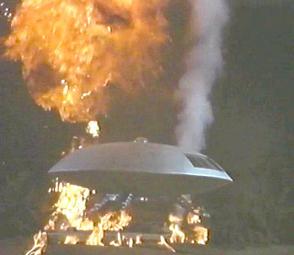
The second season of Lost in Space started with a literal blast!
Lost in Space started its second season not only in beautiful color but also with upgraded opening titles and sets. The actor’s costumes were also modified to take advantage of the color. The tone of the shows became lighter with more comical aliens and the newly revised personality of Dr. Smith. The opening episode, Blast Off into Space, got the Jupiter 2 off the ground for the first time since the early episodes of season one. After initially setting course for Alpha Centauri, they ended up lost again after rescuing Dr. Smith from a space siren in Wild Adventure. It didn’t take long for them to land on another planet and settle back into the dynamic of the earlier season.
Fans generally consider season two of Lost in Space to be the transitional one. The Jupiter 2 returned to space but the show still leaned toward planet based adventures. This was also the season where the stories shifted away from the family in favor of Will, Dr. Smith, the robot, and the monster of the week! Introduced this season were the bizarre android machines that seemed to be intergalactic shopping catalogs and some equally strange characters like space knights, pirates, Vikings, and cowboys. Even a distant relative of Dr. Smith somehow crossed paths with the Robinsons. The more memorable episodes included A Trip through the Robot, the beauty parable The Golden Man, A Visit to Hades, and the stock footage heavy Prisoners of Space where the Robinson’s are put on trail for crimes they did not realize they committed.
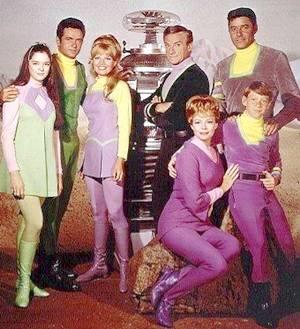
A third season publicity photo showing the cast's updated costumes.
It was back into space for the crew of the Jupiter 2 as season three kicked off with The Condemned of Space, where a stop at a galactic prison almost ends in a jail break and Robby the Robot guest stars again. The ship would remain mobile for the remainder of this season and, in addition to a much livelier opening credit sequence complete with a numeric countdown, a space pod was added that allowed small groups to travel between the Jupiter 2 and nearby planets. The stories continued with a light hearted tone but became more creative thanks to the now mobile characters.
A pair of interesting stories this season both saw the Robinsons, or at least various members, return to Earth if only temporarily. In A Visit to a Hostile Planet, the Jupiter 2 actually lands back on Earth but due to a time warp it is Earth of 1947! They are mistaken for invaders, attacked by a small town militia, and must escape from the planet they will call home in the future. The Time Merchant gave viewers an even more intriguing premise when Dr. Smith uses an alien’s technology to return to Earth on the day of the Jupiter 2’s launch so he can forgo the sabotage attempt and let them continue their mission as planned. Unfortunately Smith discovers that it was his interferences that actually saved the Robinsons and Major West from being killed in a space disaster and he must set time right again or they will perish.
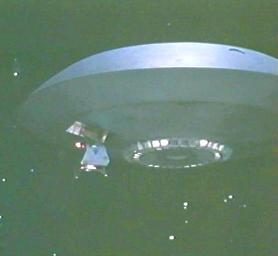
The space pod added for season three departs for a nearby planet.
Season three produced several other good episodes including Space Creature, Target: Earth, and the fan favorite The Anti-Matter Man, which gave actors Guy Williams and Mark Goddard the opportunity to play their evil duplicates. This season also had its fair share of duds too including one that would be indelibly associated with the show forever, The Great Vegetable Rebellion. For anyone who wonders if the scripts were getting a little too far out, this story of a planet where plants are the highest form of life should be more than answer enough. The ruler is a giant carrot named Tybo who turns Dr. Smith into a stalk of celery as punishment for picking flowers! Sadly, this was the second to the last episode of the show broadcast and the series finale, Junkyard in Space was not much better.
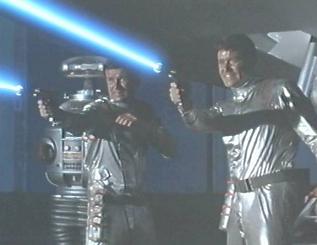
Lost in Space was a family show but it wasn't afraid of a little gun play.
Mark Goddard once told me that when the third season of Lost in Space wrapped, everyone went home for the break fully expecting to be back for season four. It was not until the time the new scripts should have been arriving that the actor’s became suspicious and were eventually told the series was not being renewed. While no formal explanation for CBS’s decision to cancel the show has ever been given, declining ratings and the sizable budget required by the series are the most often cited reasons. The cast was also starting to grow tired of the sillier stories to the point that Guy Williams and June Lockhart were often written out of episodes in the third season or had their roles greatly diminished.
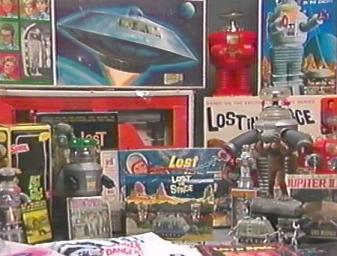 To date, Lost in Space is the only one of Irwin Allen’s science fiction television series to see the light of the big screen. Allen supposedly had a version in development at the time of his death and several cast members tried to stimulate interest in a movie deal over the years but nothing materialized. It would take exactly thirty years from the time the series went off the air until a feature film was released in 1998. Directed by Stephen Hopkins, the film re-envisioned the premise of a family being launched on a deep space voyage but these were darker times and the Robinsons of the feature were nowhere near as functional as their television counterparts. The character of Dr. Smith was returned to his original evil ways and becomes the true villain of the story earning a fate television audiences could have never imagined for Jonathan Harris. In spite of cameos from many of the original series actors, clever visual nods to the show, and even Dick Tufeld reprising his role of the robot’s voice, this version failed to endear itself to audiences and did less than stellar business at the box office.
To date, Lost in Space is the only one of Irwin Allen’s science fiction television series to see the light of the big screen. Allen supposedly had a version in development at the time of his death and several cast members tried to stimulate interest in a movie deal over the years but nothing materialized. It would take exactly thirty years from the time the series went off the air until a feature film was released in 1998. Directed by Stephen Hopkins, the film re-envisioned the premise of a family being launched on a deep space voyage but these were darker times and the Robinsons of the feature were nowhere near as functional as their television counterparts. The character of Dr. Smith was returned to his original evil ways and becomes the true villain of the story earning a fate television audiences could have never imagined for Jonathan Harris. In spite of cameos from many of the original series actors, clever visual nods to the show, and even Dick Tufeld reprising his role of the robot’s voice, this version failed to endear itself to audiences and did less than stellar business at the box office.
1968 saw the cancellation of two long running Irwin Allen series, Lost in Space after the three seasons and 83 episodes, and the slightly longer lived, by one season, Voyage to the Bottom of the Sea. Allen was already busy at work on a brand new concept that he thought would take television by storm, Land of the Giants, which was set to premier later that same year. After leaving prime time, Lost in Space thrived in syndication where millions of kids just like me rushed home every day after school to watch the adventures of the Robinson family in the 70’s. Later the show would be picked up by larger cable stations like TBS, USA, and the Sci-Fi Channel (back when they really did show quality science fiction) making it the most watched and best loved among all of Irwin Allen’s television series.
